GMC ACADIA 2008 Owner's Manual
Manufacturer: GMC, Model Year: 2008, Model line: ACADIA, Model: GMC ACADIA 2008Pages: 472, PDF Size: 5.72 MB
Page 391 of 472
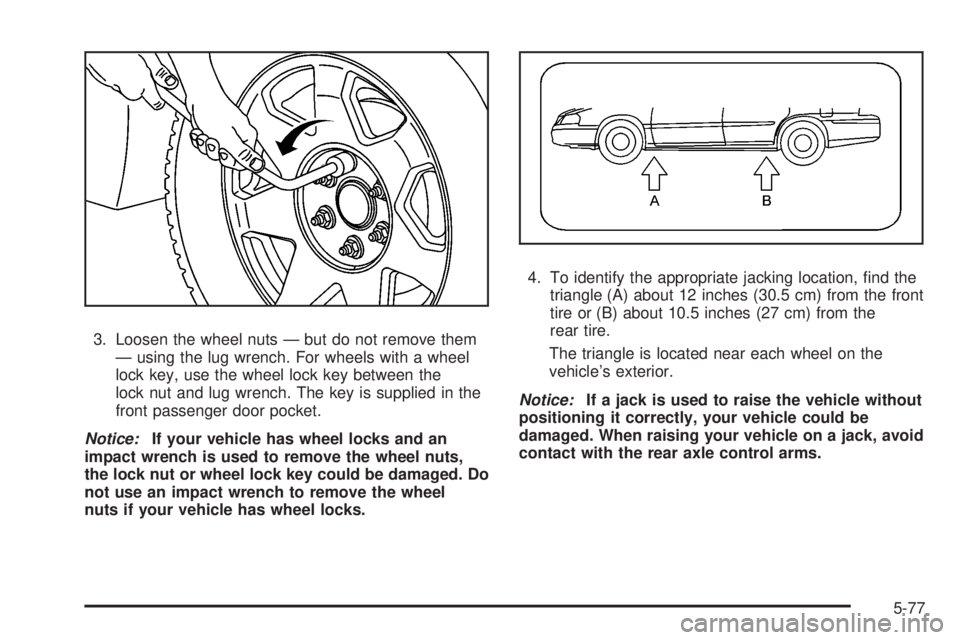
3. Loosen the wheel nuts — but do not remove them
— using the lug wrench. For wheels with a wheel
lock key, use the wheel lock key between the
lock nut and lug wrench. The key is supplied in the
front passenger door pocket.
Notice:If your vehicle has wheel locks and an
impact wrench is used to remove the wheel nuts,
the lock nut or wheel lock key could be damaged. Do
not use an impact wrench to remove the wheel
nuts if your vehicle has wheel locks.4. To identify the appropriate jacking location, �nd the
triangle (A) about 12 inches (30.5 cm) from the front
tire or (B) about 10.5 inches (27 cm) from the
rear tire.
The triangle is located near each wheel on the
vehicle’s exterior.
Notice:If a jack is used to raise the vehicle without
positioning it correctly, your vehicle could be
damaged. When raising your vehicle on a jack, avoid
contact with the rear axle control arms.
5-77
Page 392 of 472
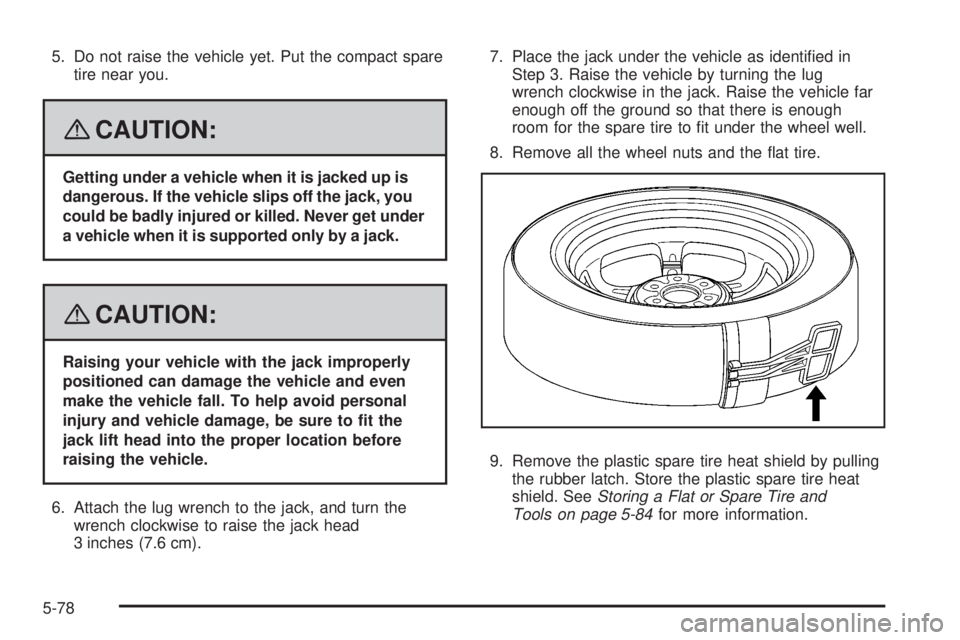
5. Do not raise the vehicle yet. Put the compact spare
tire near you.
{CAUTION:
Getting under a vehicle when it is jacked up is
dangerous. If the vehicle slips off the jack, you
could be badly injured or killed. Never get under
a vehicle when it is supported only by a jack.
{CAUTION:
Raising your vehicle with the jack improperly
positioned can damage the vehicle and even
make the vehicle fall. To help avoid personal
injury and vehicle damage, be sure to �t the
jack lift head into the proper location before
raising the vehicle.
6. Attach the lug wrench to the jack, and turn the
wrench clockwise to raise the jack head
3 inches (7.6 cm).7. Place the jack under the vehicle as identi�ed in
Step 3. Raise the vehicle by turning the lug
wrench clockwise in the jack. Raise the vehicle far
enough off the ground so that there is enough
room for the spare tire to �t under the wheel well.
8. Remove all the wheel nuts and the �at tire.
9. Remove the plastic spare tire heat shield by pulling
the rubber latch. Store the plastic spare tire heat
shield. SeeStoring a Flat or Spare Tire and
Tools on page 5-84for more information.
5-78
Page 393 of 472
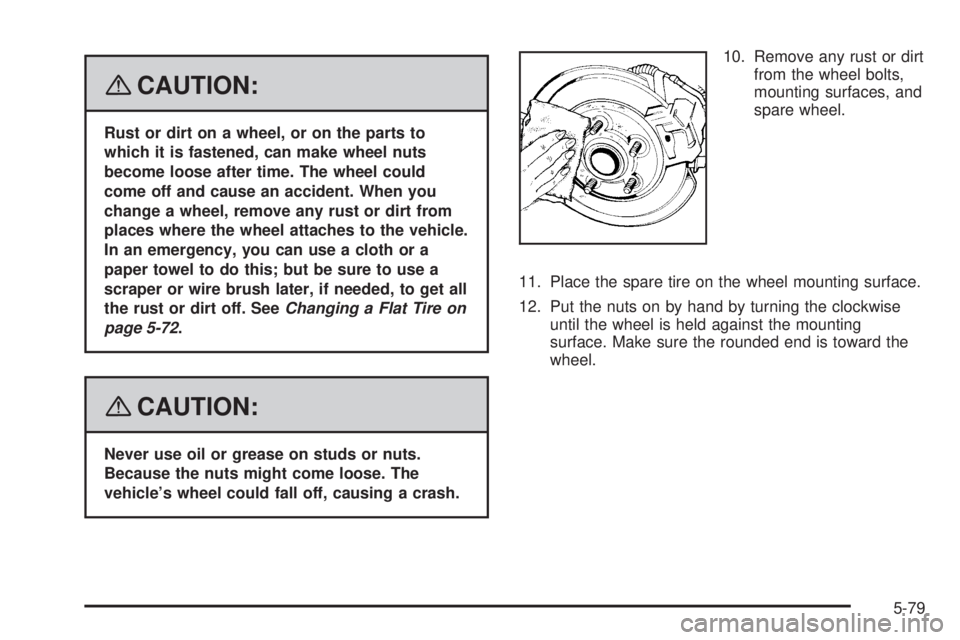
{CAUTION:
Rust or dirt on a wheel, or on the parts to
which it is fastened, can make wheel nuts
become loose after time. The wheel could
come off and cause an accident. When you
change a wheel, remove any rust or dirt from
places where the wheel attaches to the vehicle.
In an emergency, you can use a cloth or a
paper towel to do this; but be sure to use a
scraper or wire brush later, if needed, to get all
the rust or dirt off. SeeChanging a Flat Tire on
page 5-72.
{CAUTION:
Never use oil or grease on studs or nuts.
Because the nuts might come loose. The
vehicle’s wheel could fall off, causing a crash.10. Remove any rust or dirt
from the wheel bolts,
mounting surfaces, and
spare wheel.
11. Place the spare tire on the wheel mounting surface.
12. Put the nuts on by hand by turning the clockwise
until the wheel is held against the mounting
surface. Make sure the rounded end is toward the
wheel.
5-79
Page 394 of 472
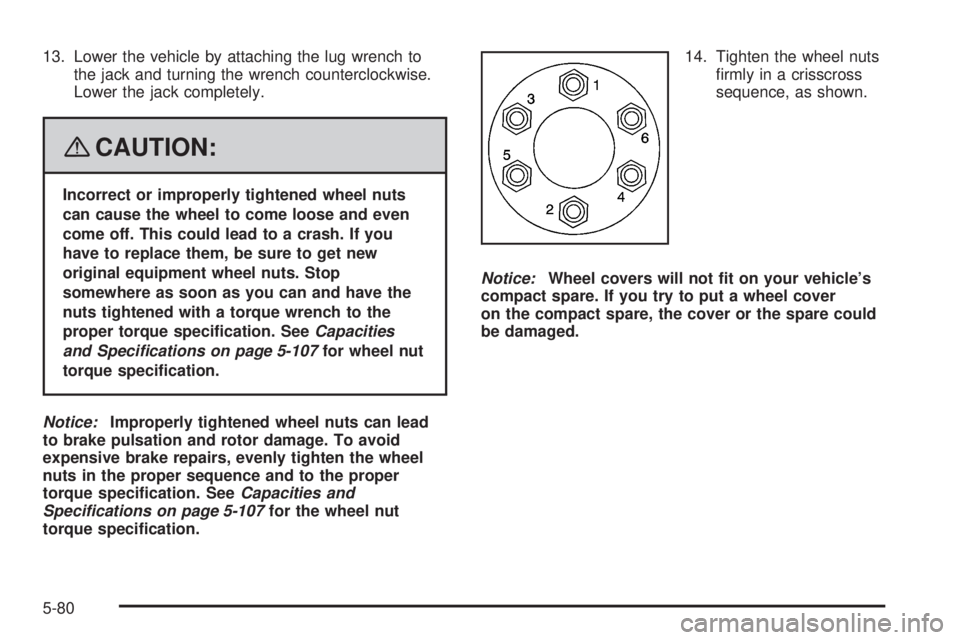
13. Lower the vehicle by attaching the lug wrench to
the jack and turning the wrench counterclockwise.
Lower the jack completely.
{CAUTION:
Incorrect or improperly tightened wheel nuts
can cause the wheel to come loose and even
come off. This could lead to a crash. If you
have to replace them, be sure to get new
original equipment wheel nuts. Stop
somewhere as soon as you can and have the
nuts tightened with a torque wrench to the
proper torque speci�cation. SeeCapacities
and Specifications on page 5-107for wheel nut
torque speci�cation.
Notice:Improperly tightened wheel nuts can lead
to brake pulsation and rotor damage. To avoid
expensive brake repairs, evenly tighten the wheel
nuts in the proper sequence and to the proper
torque speci�cation. SeeCapacities and
Specifications on page 5-107for the wheel nut
torque speci�cation.14. Tighten the wheel nuts
�rmly in a crisscross
sequence, as shown.
Notice:Wheel covers will not �t on your vehicle’s
compact spare. If you try to put a wheel cover
on the compact spare, the cover or the spare could
be damaged.
5-80
Page 395 of 472
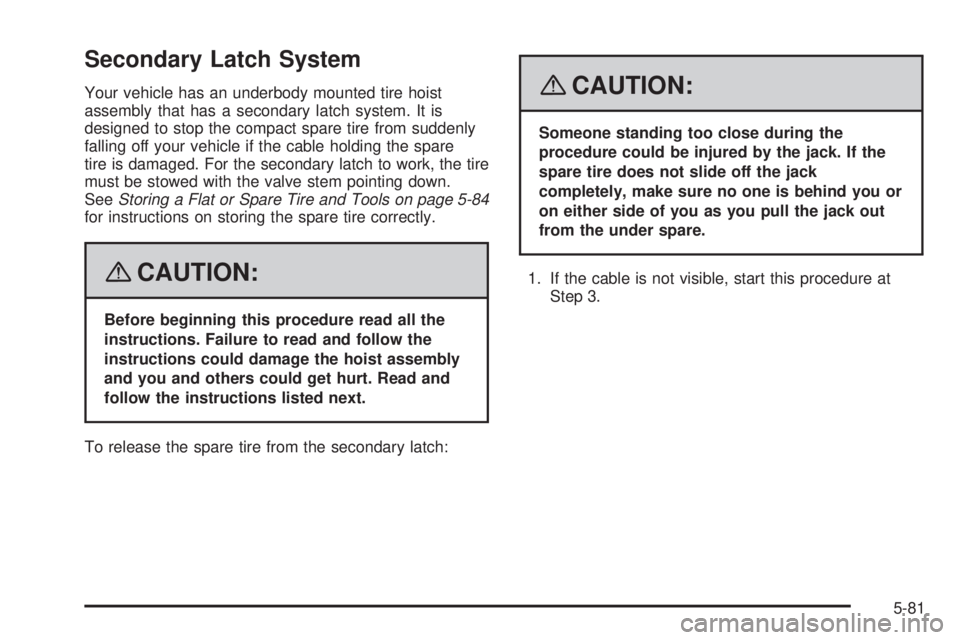
Secondary Latch System
Your vehicle has an underbody mounted tire hoist
assembly that has a secondary latch system. It is
designed to stop the compact spare tire from suddenly
falling off your vehicle if the cable holding the spare
tire is damaged. For the secondary latch to work, the tire
must be stowed with the valve stem pointing down.
SeeStoring a Flat or Spare Tire and Tools on page 5-84
for instructions on storing the spare tire correctly.
{CAUTION:
Before beginning this procedure read all the
instructions. Failure to read and follow the
instructions could damage the hoist assembly
and you and others could get hurt. Read and
follow the instructions listed next.
To release the spare tire from the secondary latch:
{CAUTION:
Someone standing too close during the
procedure could be injured by the jack. If the
spare tire does not slide off the jack
completely, make sure no one is behind you or
on either side of you as you pull the jack out
from the under spare.
1. If the cable is not visible, start this procedure at
Step 3.
5-81
Page 396 of 472
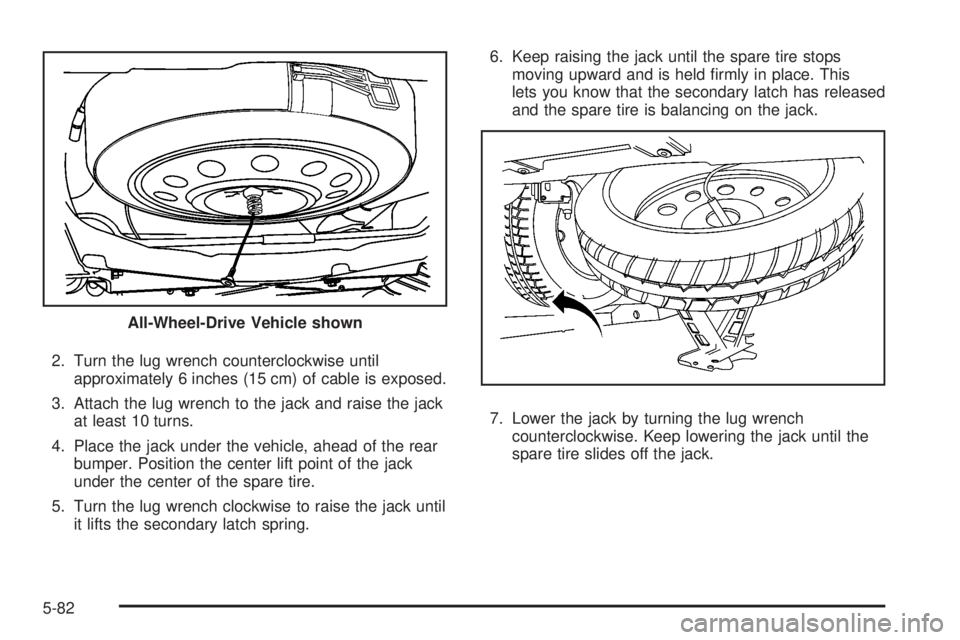
2. Turn the lug wrench counterclockwise until
approximately 6 inches (15 cm) of cable is exposed.
3. Attach the lug wrench to the jack and raise the jack
at least 10 turns.
4. Place the jack under the vehicle, ahead of the rear
bumper. Position the center lift point of the jack
under the center of the spare tire.
5. Turn the lug wrench clockwise to raise the jack until
it lifts the secondary latch spring.6. Keep raising the jack until the spare tire stops
moving upward and is held �rmly in place. This
lets you know that the secondary latch has released
and the spare tire is balancing on the jack.
7. Lower the jack by turning the lug wrench
counterclockwise. Keep lowering the jack until the
spare tire slides off the jack. All-Wheel-Drive Vehicle shown
5-82
Page 397 of 472
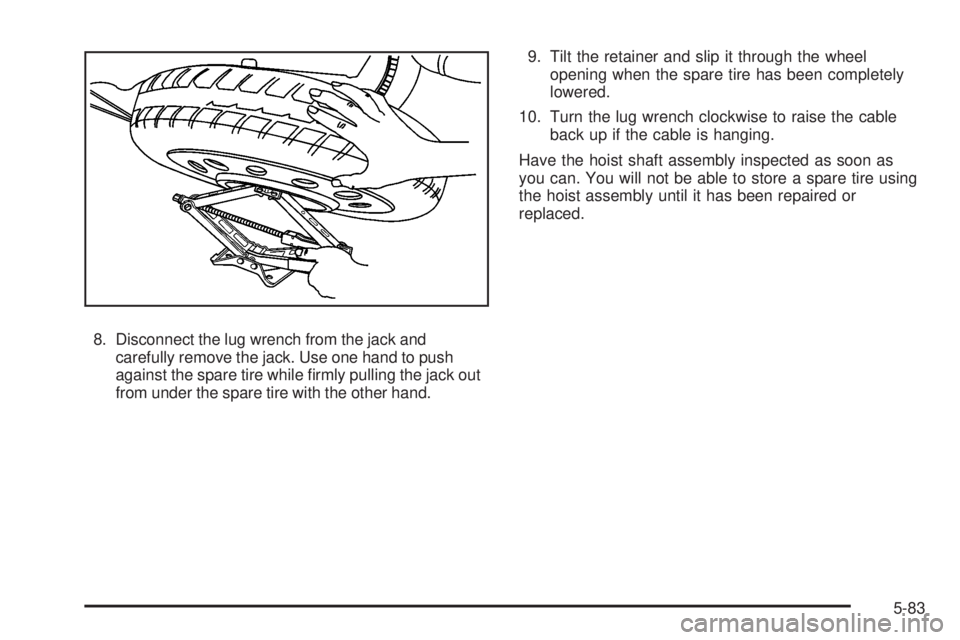
8. Disconnect the lug wrench from the jack and
carefully remove the jack. Use one hand to push
against the spare tire while �rmly pulling the jack out
from under the spare tire with the other hand.9. Tilt the retainer and slip it through the wheel
opening when the spare tire has been completely
lowered.
10. Turn the lug wrench clockwise to raise the cable
back up if the cable is hanging.
Have the hoist shaft assembly inspected as soon as
you can. You will not be able to store a spare tire using
the hoist assembly until it has been repaired or
replaced.
5-83
Page 398 of 472
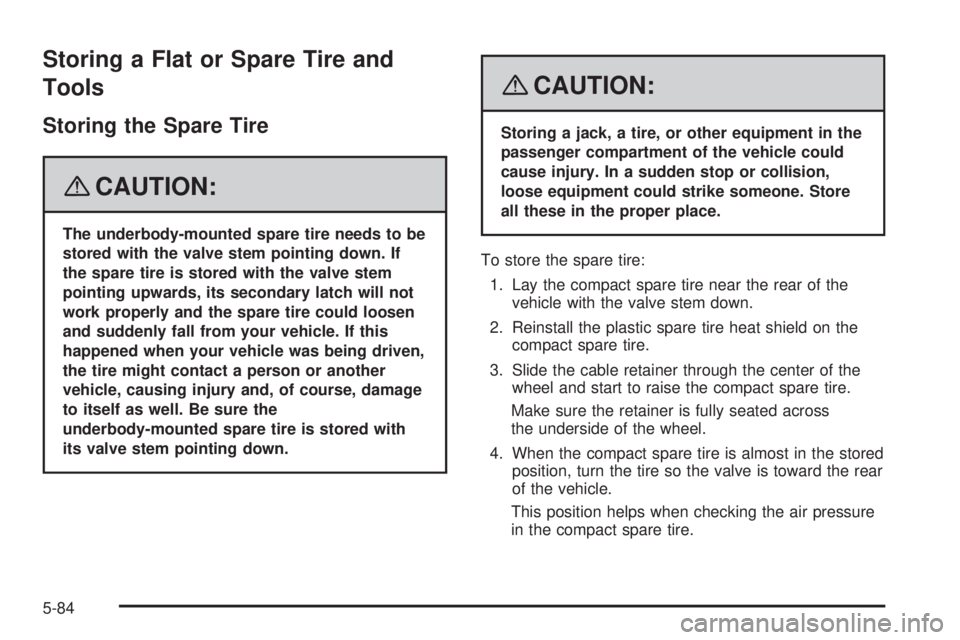
Storing a Flat or Spare Tire and
Tools
Storing the Spare Tire
{CAUTION:
The underbody-mounted spare tire needs to be
stored with the valve stem pointing down. If
the spare tire is stored with the valve stem
pointing upwards, its secondary latch will not
work properly and the spare tire could loosen
and suddenly fall from your vehicle. If this
happened when your vehicle was being driven,
the tire might contact a person or another
vehicle, causing injury and, of course, damage
to itself as well. Be sure the
underbody-mounted spare tire is stored with
its valve stem pointing down.
{CAUTION:
Storing a jack, a tire, or other equipment in the
passenger compartment of the vehicle could
cause injury. In a sudden stop or collision,
loose equipment could strike someone. Store
all these in the proper place.
To store the spare tire:
1. Lay the compact spare tire near the rear of the
vehicle with the valve stem down.
2. Reinstall the plastic spare tire heat shield on the
compact spare tire.
3. Slide the cable retainer through the center of the
wheel and start to raise the compact spare tire.
Make sure the retainer is fully seated across
the underside of the wheel.
4. When the compact spare tire is almost in the stored
position, turn the tire so the valve is toward the rear
of the vehicle.
This position helps when checking the air pressure
in the compact spare tire.
5-84
Page 399 of 472
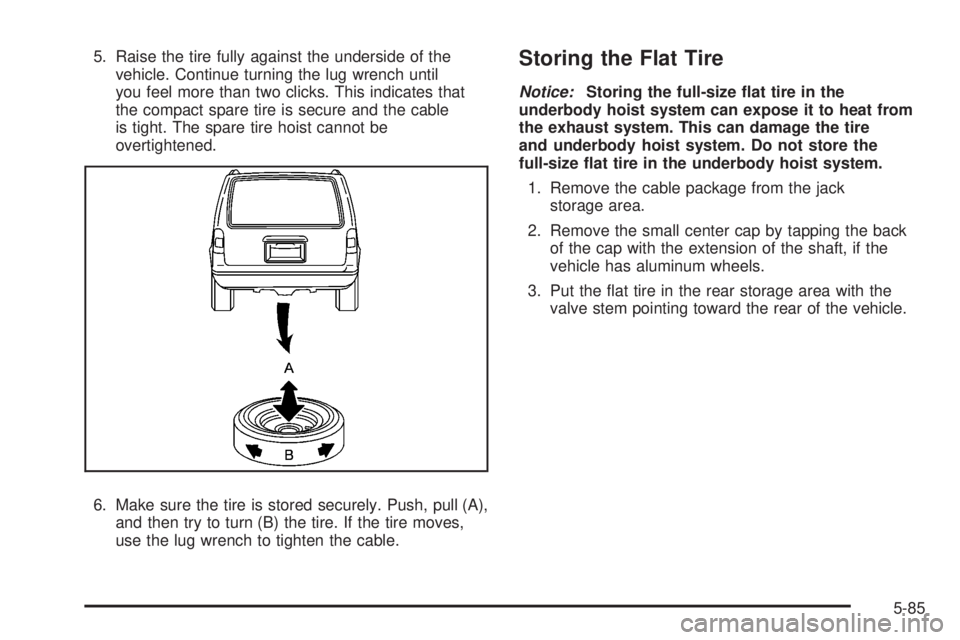
5. Raise the tire fully against the underside of the
vehicle. Continue turning the lug wrench until
you feel more than two clicks. This indicates that
the compact spare tire is secure and the cable
is tight. The spare tire hoist cannot be
overtightened.
6. Make sure the tire is stored securely. Push, pull (A),
and then try to turn (B) the tire. If the tire moves,
use the lug wrench to tighten the cable.Storing the Flat Tire
Notice:Storing the full-size �at tire in the
underbody hoist system can expose it to heat from
the exhaust system. This can damage the tire
and underbody hoist system. Do not store the
full-size �at tire in the underbody hoist system.
1. Remove the cable package from the jack
storage area.
2. Remove the small center cap by tapping the back
of the cap with the extension of the shaft, if the
vehicle has aluminum wheels.
3. Put the �at tire in the rear storage area with the
valve stem pointing toward the rear of the vehicle.
5-85
Page 400 of 472
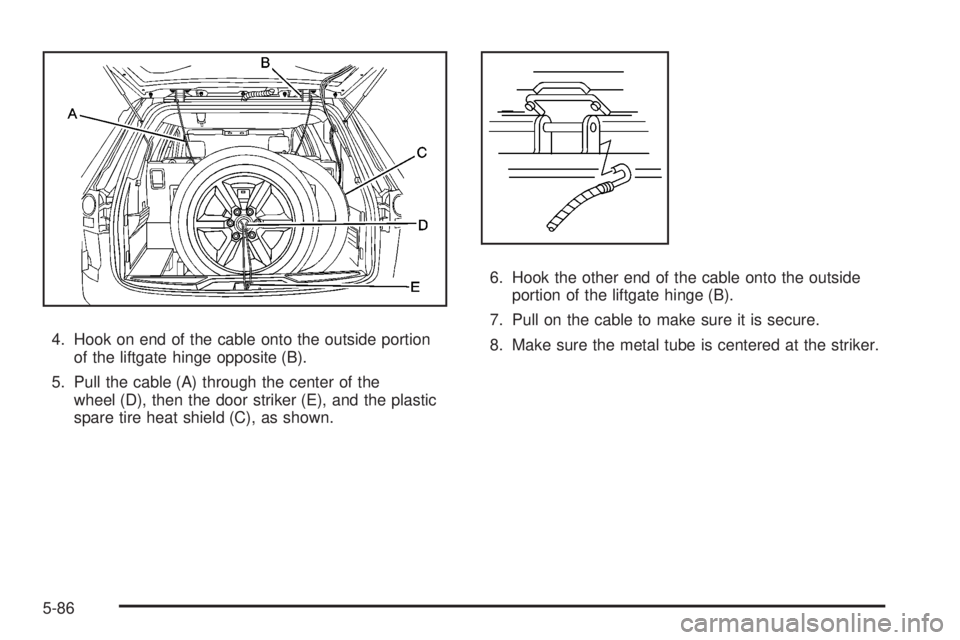
4. Hook on end of the cable onto the outside portion
of the liftgate hinge opposite (B).
5. Pull the cable (A) through the center of the
wheel (D), then the door striker (E), and the plastic
spare tire heat shield (C), as shown.6. Hook the other end of the cable onto the outside
portion of the liftgate hinge (B).
7. Pull on the cable to make sure it is secure.
8. Make sure the metal tube is centered at the striker.
5-86